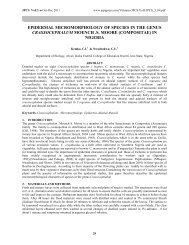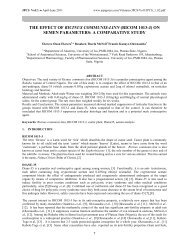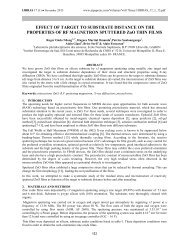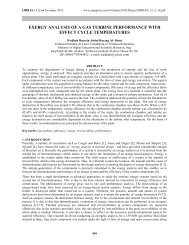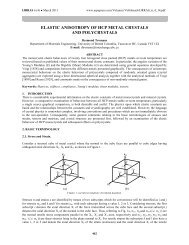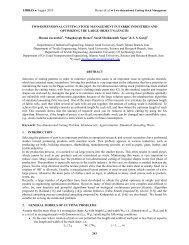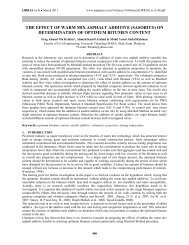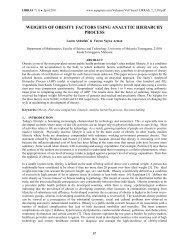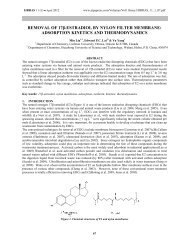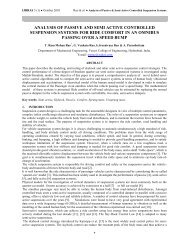CHAPTER 1 - International Journal of Research and Reviews in ...
CHAPTER 1 - International Journal of Research and Reviews in ...
CHAPTER 1 - International Journal of Research and Reviews in ...
You also want an ePaper? Increase the reach of your titles
YUMPU automatically turns print PDFs into web optimized ePapers that Google loves.
IJRRAS 2 (3) ● March 2010 Denan & al. ● Study <strong>of</strong> Lateral Buckl<strong>in</strong>g Behavior <strong>of</strong> Beam<br />
3.1 Modell<strong>in</strong>g<br />
LUSAS models are def<strong>in</strong>ed <strong>in</strong> terms <strong>of</strong> geometric features that must be subdivided <strong>in</strong>to f<strong>in</strong>ite elements for<br />
solution. This process <strong>of</strong> sub division is called mesh<strong>in</strong>g. Mesh datasets conta<strong>in</strong> <strong>in</strong>formation about element types,<br />
element discretisation <strong>and</strong> mesh type. The I-beam models were assigned ungraded mild steel for its material<br />
property with Young‟s modulus, E= 209x10 3 N/mm 2 , shear modulus, G = 79x10 3 N/mm 2 <strong>and</strong> Poisson ratio <strong>of</strong> 0.3.<br />
The beams are simply supported <strong>and</strong> unrestra<strong>in</strong>ed laterally.<br />
The convergence <strong>of</strong> the mesh was established by <strong>in</strong>dependently <strong>in</strong>creas<strong>in</strong>g the mesh density <strong>in</strong> each part <strong>of</strong><br />
the model beam section. The model was also analysis with <strong>in</strong>creased mesh density <strong>in</strong> all parts <strong>of</strong> the section<br />
simultaneously, <strong>and</strong> with higher-order elements (QSL8).<br />
3.2 Eigenvalue Buckl<strong>in</strong>g Analysis<br />
The ma<strong>in</strong> objective <strong>in</strong> the eigenvalue buckl<strong>in</strong>g analysis is to obta<strong>in</strong> the critical buckl<strong>in</strong>g load, by solv<strong>in</strong>g the<br />
associated eigenvalue problem. In LUSAS, there are two methods to obta<strong>in</strong> <strong>in</strong>formation regard<strong>in</strong>g buckl<strong>in</strong>g loads<br />
<strong>and</strong> their respective deformation mode i.e. The l<strong>in</strong>ear eigenvalue buckl<strong>in</strong>g analysis <strong>and</strong> the full geometrically nonl<strong>in</strong>ear<br />
analysis. Figure 6 show a typical buckl<strong>in</strong>g shape <strong>in</strong> Mode 1.<br />
Y<br />
X<br />
Z<br />
Figure 6 : The buckl<strong>in</strong>g shape mode 1<br />
Modes 1,2, <strong>and</strong> 3 represents the buckl<strong>in</strong>g shape <strong>of</strong> the element. In this study the result <strong>of</strong> mode one would<br />
be considered; because it was found that all the beam specimen failed <strong>in</strong> the tests due to this mode. This is also<br />
because mode one is the least value. It will be unrealistic to choose the higher modes 2 <strong>and</strong> 3 to get the critical<br />
buckl<strong>in</strong>g load. The resulted eigenvalues are actually the load factors to be multiplied to the applied load<strong>in</strong>g, to obta<strong>in</strong><br />
critical buckl<strong>in</strong>g load. The eigenvalue buckl<strong>in</strong>g analysis <strong>in</strong> LUSAS Modeller will provide both local <strong>and</strong> global<br />
buckl<strong>in</strong>g modes. Eng<strong>in</strong>eer<strong>in</strong>g judgment is necessary to determ<strong>in</strong>e which buckl<strong>in</strong>g mode is the most critical <strong>in</strong> order<br />
to select the appropriate buckl<strong>in</strong>g load factor. It is, <strong>of</strong> course possible to visually exam<strong>in</strong>e the resultant modes <strong>in</strong><br />
LUSAS Modeller.<br />
237



